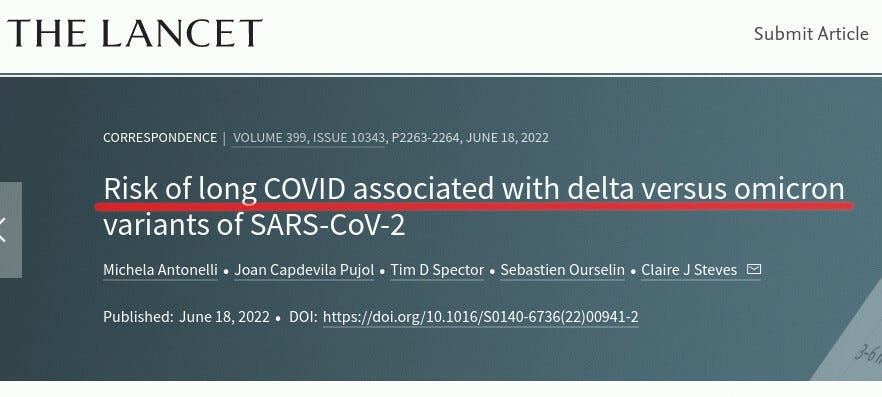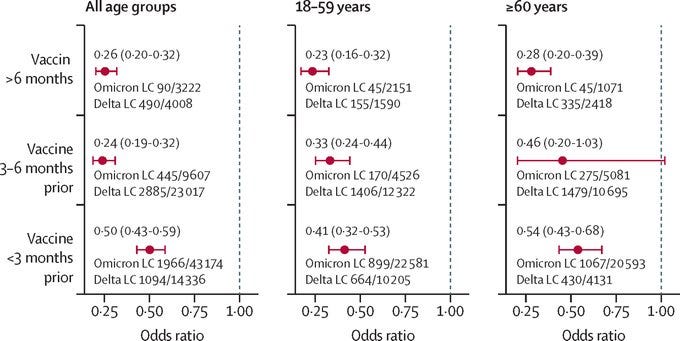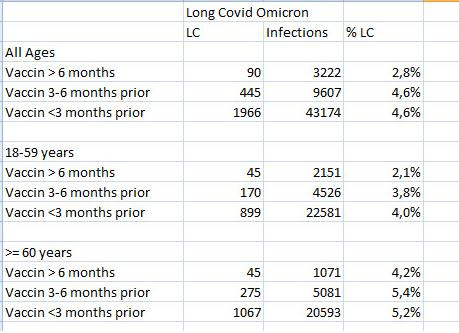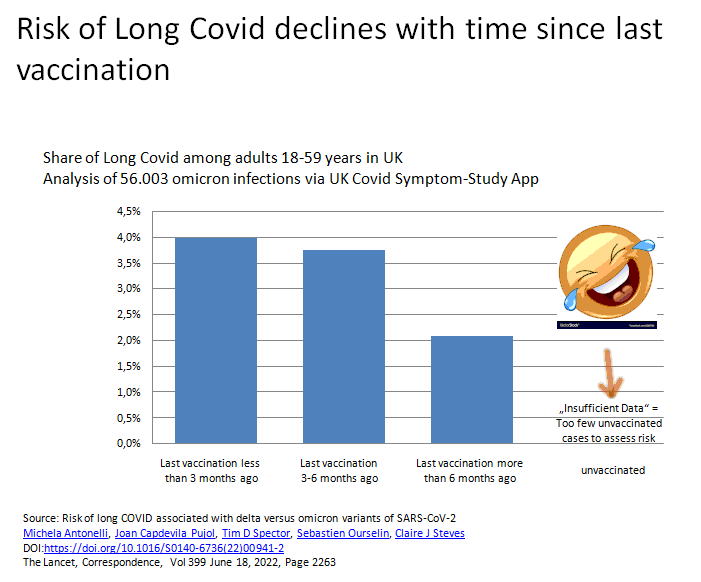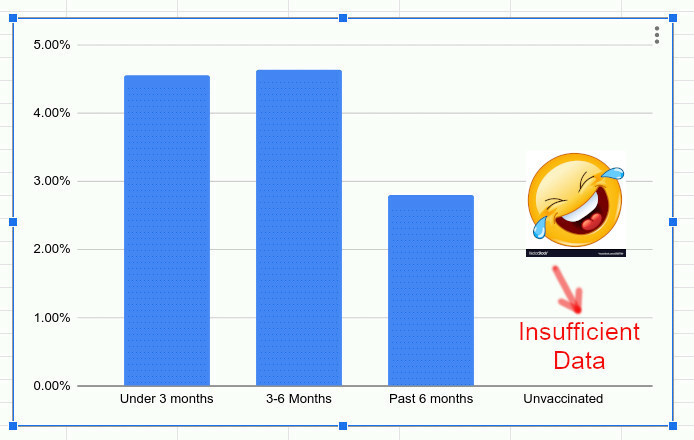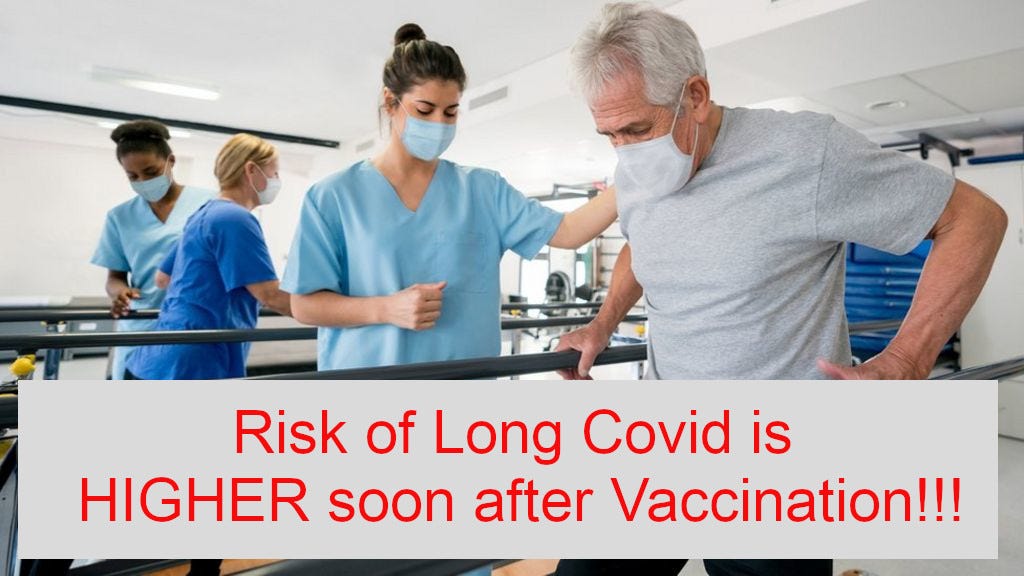Worden we wakker? Informeer je! Deel deze informatie over "De Oorlog tegen de Mensheid" + 8.431 posts
dinsdag 22 november 2022
Long Covid MORE Likely to Happen SOON AFTER VACCINATION
Long Covid is real. It refers to people having new long-term conditions that reduce their quality of life, which started soon after a documented Covid infection. I know a few people who have it. Two of them were unvaccinated when they had Covid and went on to develop Long Covid. (a lot of people I know happen to be unvaccinated) I also know vaccinated people who had Long Covid, and luckily one of them recovered after a few months of great unpleasantness.
I will show, below, that people are at the HIGHEST risk of Long Covid — gasp — RIGHT AFTER Covid vaccination!
Analyst Olaf Garber, Germany
A German economist and analyst, @OlafGarber, recently brought up very interesting Long Covid data in an online conversation with me.
NOTE: Olaf Garber is not a stranger to the world of Covid analysis. He also extensively researched excess mortality, like I did, and came up with amazing conclusions that go in the same general direction as my excess mortality articles but involve data he derived and analyzed independently. So his conclusions serve as important checks on my conclusions and vice versa. Here’s his chart of excess mortality vs. booster rates (archive link):
His independent chart nicely parallels my chart of mortality vs. booster rates. @OlafGarber is a person to take note of and follow!
Long Covid and Date of Vaccination
Here’s an article titled “Risk of long COVID associated with delta versus omicron variants.”
The article has a chart that has all the data we need — we need to rearrange it:
The risk of Long Covid for the Omicron period declines with time from the last vaccination:
Age 18-59:
All Ages:
Oddly enough, they “did not have enough data for the unvaccinated.”
We had insufficient data to estimate the odds of long COVID in unvaccinated individuals and did not estimate effects in children.
So here you can see easily that the greatest risk of Long Covid is “soon after vaccination.” The risk of Long Covid goes down as time passes from the last vaccination.
This both validates what antivaxxers have been saying — that vaccination makes Long Covid more likely — and also provides hope for vaccinated people that their risk of Long Covid goes down if they stay away from boosters. This is good news for all people!
A lot of people misattribute direct vaccine damage to Long Covid. Here’s a sad example of a Redditor who thinks their vaccine damage may be “Long Covid” - even though the Covid around Nov 2021 was long before the January 2022 booster that caused the damage.
Poll: Please Share Your Long Covid Stories
I want to use this post to ask YOU for “your Long Covid Story.” Tell us if you, your friends, or your relatives, had Long Covid, their vaccination status, and the symptoms the person experienced.
Please be mindful of people’s and your privacy! You can describe yourself in the third person. “A friend of mine….” Also, please be kind in describing individuals and their suffering. You are, as always, allowed to disagree here or question the existence of Long Covid — state your thoughts clearly — but please be polite.
Let’s see if, perhaps, we can see some patterns emerging!
Thanks for reading Igor’s Newsletter! Subscribe for free to receive new posts and support my work.
© 2022 Igor Chudov , 548 Market Street PMB 72296, San Francisco, CA 94104
Source: Long Covid soon after Vaxx
maandag 21 november 2022
Begrafenisondernemer schiet uit zijn slof: ‘Wat mankeert deze mensen? Dit is echt ziek’
Toen de Britse begrafenisondernemer John O’Looney onlangs bij de apotheek was om pijnstillers te halen, kwam er een zorgmedewerker binnen met een oude man. Die stond op het punt een griepprik te krijgen.
O’Looney werd boos, want hij weet wat de griepvaccins aanrichten bij oude mensen. Hij sprak haar aan en zei tegen haar dat hij een begrafenisondernemer is en dat veel mensen sterven nadat ze die prikken hebben gehaald.
(Video verwijderd? Klik hier...)
Betaald
“Dat weet ik,” zei de zorgmedewerker. “Ik heb er niets over te zeggen. Ik moet het doen.” O’Looney zei tegen de oude man: “Als ik jou was, zou ik die griepprik niet nemen.”
“Dit is wat ze doen. Ze laten die mensen een griepprik halen terwijl ze weten dat ze eraan sterven,” zegt de begrafenisondernemer in een vlog. Over de zorgwerker zegt hij: “Weet je waarom ze het doet? Omdat ze ervoor betaald krijgt. Stuk tuig.”
Deze mensen zijn ziek
“Wat mankeert deze mensen? Het is ziek. Echt ziek. Deze mensen zijn ziek,” fulmineert O’Looney.
Sinds enkele maanden kunnen Britten zowel een boosterprik tegen corona als een gratis griepprik halen.
Patholoog woest: iedere arts die hieraan heeft meegedaan, moet de gevangenis in
Is het tijd om te vergeven en vergeten? Die vraag legde Robert Vaughan van Just Right Media voor aan patholoog Roger Hodkinson. “Absoluut niet,” antwoordde Hodkinson, die vol wraakgevoelens zit.
Hoe kun je zoiets doen?
Die sterfte is volgens hem rechtstreeks het gevolg van de maatregelen die de idioten hebben ingevoerd. Niet alleen de politici, maar vooral de artsen zijn de hoofdschuldigen omdat zij de patiëntenzorg uit handen hebben gegeven aan de overheid. “Dat is nog nooit eerder gebeurd.”
Ten eerste, geen kwaad doen en geïnformeerde toestemming, zei hij, verwijzende naar de artseneed. “Hoe kun je zoiets doen?” aldus een woeste Hodkinson. “Hoe kun je tegen een zwangere vrouw zeggen dat dit experimentele product veilig is? Hoe kan een arts zoiets doen? Iedere arts die dit heeft gedaan, moet de gevangenis in.”
Tsunami van sterfgevallen
De patholoog was tot voor kort lid van het College of American Pathologists. Ze besloten hem eruit te werken wegens het verspreiden van ‘misinformatie’. Hij waarschuwt voor een tsunami van sterfgevallen omdat het immuunsysteem van veel mensen naar de gallemiezen is.
What You Need to Know About Melatonin
This 3 billion-year-old antioxidant eats vitamin C for breakfast.
LINK: https://www.bitchute.com/video/mKzPPm0jwqcD/
Download Interview Transcript | Download my FREE Podcast
STORY AT-A-GLANCE
- Melatonin is one of
the most important antioxidant molecules and certainly the most ancient,
as it has been part of biological life for over 3 billion years. It's
present in prokaryotes, which are bacteria, and even in plants
- In the human body
melatonin not only has independent direct antioxidant effects on its own,
but it also stimulates the synthesis of glutathione and other important
antioxidants like superoxide dismutase and catalase
- Mitochondrial
melatonin production is one of the reasons why regular sun exposure is so
crucial. The near-infrared spectrum, when hitting the skin, trigger the
generation of melatonin in your mitochondria
- Considering melatonin’s
function within the mitochondria, and the fact that mitochondrial
dysfunction is a hallmark of most chronic disease, it makes sense that
melatonin would be helpful against a number of different diseases,
including the two most common — heart disease and cancer
- Melatonin and
methylene blue belong in every emergency medical kit. In cases of an acute
heart attack or stroke, melatonin can help limit the damage, while
methylene blue augments cytochromes to allow the continued production of
ATP even without the use of oxygen, which also helps minimize cell death
and tissue damage
In this
interview, Russel Reiter, Ph.D. — a world-class expert on melatonin — discusses
some of the biological activities and health benefits of this important
molecule. With some 1,600 papers to his credit, as well as three honorary
doctor of medicine1 degrees, he’s
published more studies on melatonin than anyone else alive.
Melatonin 101
Melatonin is
one of the most important antioxidant molecules and certainly the most ancient,
as it has been part of biological life for over 3 billion years. It's present
in prokaryotes, which are bacteria, and even in plants. In the human body —
aside from having direct antioxidant effects — it also stimulates the synthesis
of glutathione and other important antioxidants like superoxide dismutase and
catalase. Reiter continues:
“Melatonin has been here forever ... and its functions have evolved. It
has learned to work successfully with other molecules during this
three-billion-year evolution. One of the molecules with which it collaborates
is glutathione ... But the antioxidant activity of melatonin is extremely
diverse.
It in fact is a very good radical scavenger. There are other radical
scavengers — vitamin C, vitamin E and so forth — but melatonin is superior to
those. But beyond that, it stimulates antioxidative enzymes, especially in
mitochondria. Mitochondria are small organelles in the cell that generate the
bulk of the free radicals.
So, it's very important to have a good antioxidant at the level of the
mitochondria and melatonin happens to be located and is, in fact, synthesized
in the mitochondria. Melatonin scavenges radicals that are generated, but it
also stimulates something called sirtuin-3, which activates or deacetylates
super oxide dismutase (SOD), which is a very important antioxidative enzyme.
It also removes free radicals and prevents the degeneration of the
mitochondria, and why this is so important is because mitochondria are really
the center of the action within a cell. In other words, there's strong evidence
that aging, frailty of aging, senescence of cells as we age, relate to
molecular damage at the level of the mitochondria, and melatonin seems to be
very efficient at protecting mitochondria from that damage.”
Melatonin
increases glutathione through a genomic effect on the enzyme that regulates the
synthesis of gamma glutamylcysteine synthase, the rate limiting enzyme in
glutathione synthesis. Melatonin activates that enzyme.
Glutathione
tends to be found in high concentrations in cells, although some is also found,
to a lesser degree, in the extracellular space and the mitochondria. Meanwhile,
95% of the melatonin in your body is concentrated within the mitochondria
inside the cells.
Its
antioxidant effects are quite diverse, but include preventing free radical
generation by enhancing the efficiency of the electron transport chain so fewer
electrons leach onto oxygen molecules to generate super oxide antiradical.
How
Mitochondrial Melatonin Is Generated
Mitochondrial
melatonin production is one of the reasons why regular sun exposure is so
crucial. Most people understand that sun exposure on bare skin generates
vitamin D, courtesy of UVB (ultraviolet B radiation). Few, however, understand
that the near-infrared spectrum, when hitting your skin, triggers the
generation of melatonin in your mitochondria. Reiter explains:
“Near-infrared radiation penetrates relatively easily the skin and
subcutaneous tissues. Every one of those cells contains mitochondria and it
appears that near-infrared radiation that is detected in fact induces melatonin
production. That is important, because we now think that melatonin within
mitochondria is inducible under a lot of stressful conditions.
That is not definitively proven, but it appears that under stress, all
cells may upregulate their ability to produce melatonin because it's so highly
productive. And typically, under stress, free radicals are generated. That is
emphasized by the [fact] that in plants ... that happens.
In other words, if you expose plants to drought, heat, cold, to metal
toxicity, the first thing they do is upregulate their melatonin, because all of
those situations generate free radicals. And we suspect, although that has not
yet been definitely proven, in animal cells as well, including human [cells].”
Identifying
the specific wavelengths that trigger melatonin production can be tricky, but
generally speaking, it’s likely to be the range between 800 to 1,000 nanometers
(nm). This range of near-infrared is invisible, and has the ability to
penetrate tissue. Visible wavelengths generally do not penetrate the skin, and
therefore cannot stimulate your mitochondria.
Anytime your skin
is exposed to natural sunlight, however, you can be sure you’re receiving the
necessary wavelengths of near-infrared to generate melatonin in your
mitochondria. Conversely, when indoors under artificial lighting, you can be
certain you’re not getting any. This is because most window glass is low-e and
filters out a good portion of the near-infrared, so even sitting near a window
is not going to provide you with this benefit.
To compensate
for time spent indoors, I use a 250-watt Photo Beam near-infrared bulb from
SaunaSpace in my office. I keep it lit when I'm in my office and have my shirt
off. Considering most people spend most of their days indoors, mitochondrial
melatonin deficiency is likely rampant. And, since many also do not get enough
sleep, they also have a deficiency in the melatonin synthesized in the pineal
gland in response to darkness.
The Two Types
of Melatonin
As hinted at
above, there are two types of melatonin in your body: The melatonin produced in
your pineal gland, which traverses into your blood, and subcellular melatonin
produced inside your mitochondria.
Importantly,
the melatonin that your mitochondria produces does not escape your
mitochondria. It doesn't go into your blood. So, you're not going to directly
increase your blood or serum level of melatonin by sun exposure. But, bright
sun exposure around solar noon will indirectly help your pineal gland to
produce melatonin during the night.
It is
important to understand that your blood level of melatonin is indicative of the
melatonin produced in your pineal gland, and/or oral supplementation.
Conversely, the melatonin produced by your pineal gland cannot enter into the
mitochondria, which is why it is so important to get regular sun exposure.
Reiter explains:
“In other words, if you surgically remove the pineal gland from an
animal or human, blood levels of melatonin are essentially zero. Not totally
zero — I think what happens is that the mitochondria in other cells continue to
produce melatonin and some of that leaks out into the blood and gives you a
residual — but you have no circadian rhythm.
Melatonin production in the pineal gland is highly rhythmic, depending
on the light-dark cycle. This is not true for melatonin in mitochondria. It's
not cyclic. It's not impacted by the light dark environment. It may be affected
by certain wavelengths of energy, but it's not affected by the light dark
environment.
So, blood levels are derived from the pineal gland, and this rhythm is
very important for setting circadian rhythms. In other words, the function of
that melatonin is quite different from the function of the mitochondrial
produced melatonin. It sets the rhythm. Of course, there's always some
scavenging by that melatonin as well, but the real scavenging s involved with
mitochondrial-produced melatonin.”
Oral
Supplementation Neutralizes Free Radicals
Oral
supplementation, however, can enter your cells and mitochondria. This is a
detail I was wrong about before, and which Reiter clarifies in this interview:
“If you supplement with melatonin, it can also enter cells and get into
the mitochondria as well. And that is also very important ... As you age,
mitochondrial melatonin diminishes. If you supplement with melatonin, it will
get into your mitochondria and, in fact, do what melatonin does — neutralize
free radicals and protect the mitochondria's function.”
Melatonin Is
Vital to Heart Attack and Stroke Recovery
Considering
melatonin’s function within your mitochondria, and the fact that mitochondrial
dysfunction is a hallmark of most chronic disease, it makes sense that
melatonin would be helpful against a number of different diseases, including
the two most common — heart disease and cancer.
As explained
by Reiter, one of the situations that is most devastating for the heart and
brain is temporary interruption of the blood supply as a result of a cardiac
arrest or stroke. This deprives the tissues of oxygen, and without oxygen, they
rapidly deteriorate.
When the
blood vessel reopens, which is called reperfusion, and oxygen flows back into
those oxygen-deprived cells, this tends to be the time of maximum damage, as
loads of free radicals are generated once the blood starts flowing again.
“There's a large host of studies, including some in humans, where if you
give melatonin to induced heart attack in animals or an accidental heart attack
in humans, you can preserve or reduce the amount of cardiac infarct, the amount
of damage that occurs in the heart,” Reiter says.
“There's a very famous cardiologist in the Canary Islands, professor
Dominguez-Rodriguez, whom I worked with. And we, about three years ago,
published a paper where we infused melatonin directly into the heart after the
vessel was opened. That reduced cardiac damage by roughly 40%.
The other thing that happens in a heart attack is that cardiac cells do
not regenerate. Once you lose a cardiac cell, they're done ... and are replaced
by fibrous tissue. Of course, fibrous tissue is not contractile, so you get
heart failure.
We just published a paper, again with this same cardiologist, showing
that if people who are potentially suffering with heart failure because of a
damaged heart, they survive better and longer if they are given melatonin on a
regular basis. It's a small study ... but I think that would be a worthwhile
field to exploit.”
Dosage
Suggestions for Acute Heart Attack
In terms of
dosage, it’s difficult to translate doses used in animal studies onto human
subjects. In animals, doses between 5 to 10 milligrams per kilogram of
bodyweight are used. In humans, however, the dose is calculated on the basis of
surface area rather than on body size, and that significantly reduces the
amount of melatonin that you have to give.
That said,
Reiter stresses that melatonin has no known toxic threshold, so even though we
don’t know what the ideal dose is, we do know it’s safe even at high doses.
Additionally, the timing of the dose will be important. The first dose should
be taken immediately, but subsequent melatonin dosing should follow circadian
biology, so around 10 a.m., 4 p.m., and before bed.
“If I had a heart attack and I had melatonin on my person, I would take
melatonin,” Reiter says. “The question is how much? ... This is not a
recommendation to any of your patients, but I would not be hesitant about
taking 50 milligrams at the time, and some subsequently for the next 24 hours,
even during the day. Because you don't want to lose any more heart cells than
is absolutely necessary ...
I have suggested this a number of times. In other words, an emergency
medical technician goes out, picks up a patient who has clearly a heart attack.
I think on site, immediately, melatonin should be given intravenously rather
than orally. It'd be difficult to give it orally. That would be my
recommendation.”
Emergency
Medical Kit for Acute Heart Attack or Stroke
In cases of
an acute heart attack or stroke (which have virtually identical tissue damage
mechanisms, just one affects the heart and the other your brain), I would also
add methylene blue. Methylene blue is well-documented to be highly beneficial
for reperfusion injuries,2 especially if you do
it right at the beginning of the event, because it augments cytochromes to
allow the continued production of ATP even without the use of oxygen.
“Melatonin
and methylene blue belong in every emergency medical kit. In cases of an acute
heart attack or stroke, melatonin can help limit the damage, while methylene blue
augments cytochromes to allow the continued production of ATP even without the
use of oxygen, which also helps minimize cell death and tissue damage.”
So, together,
methylene blue and melatonin could act as a one-two punch if you've got a
stroke or heart attack. They really should be part of every emergency kit.
As an
interesting side note, melatonin can also be useful in people with Type 2
diabetes. Reiter notes he has diabetic colleagues who take 1 gram of melatonin
daily to counteract the free radical damage caused by hyperglycemia. Keep in
mind that melatonin does not treat the cause of the diabetes. It only helps to
counteract the damage being caused.
Half Life and
Bioavailability of Melatonin
The half life
of melatonin in the blood is only about 40 minutes. Within cells, the half life
varies according to the level of oxidative stress present. If oxidative stress
is high, the melatonin is destroyed much faster, and oxidative stress is low,
it remains within the cell much longer.
Reiter also
notes that in addition to being a free radical scavenger, all of melatonin’s
metabolic kin — its active metabolites, such as N-acetyl-5-methoxytryptamine —
are also excellent scavengers. While quickly used up in the presence of high
oxidative stress, melatonin is also rapidly taken up when used orally, hence
the suggestion to take multiple doses spread out.
Ideally,
you’d want to use sublingual or intravenous melatonin, because it’ll enter your
bloodstream much faster. Another option is to make your own rectal suppositories.
If you swallow it, it needs to pass through and be metabolized by your liver.
Melatonin Is
Also a Potent Antiviral
In addition
to its antioxidant potency, melatonin also has antiviral capacity. These two
features combined is thought to be why it’s been so useful against COVID-19.
“I'm going to give you a very specific example,” Reiter says. “Here's a local physician, Dr. Richard Neil, whom I
have known for a number of years. When COVID-19 became common, he called me, we
discussed it, he started giving 1 mg per kilogram of body weight (once a day)
for about five days, at the time of diagnosis. He has now treated more than
2,000 patients, very successfully, with melatonin.
The importance of melatonin in reference to COVID is that it is not
specifically for [the original Wuhan strain]. The variants, Delta, Omicron,
they're viruses we think will respond. We currently have a paper in press where
we showed that in animals, Zika virus toxicity is also prevented by melatonin,
and we've checked four different coronaviruses in pigs.
That paper also shows that melatonin prevents the damage — the
consequence — of those viruses. I think [melatonin] is generally a quite good
antiviral agent and should be considered as useful. When President Trump was
hospitalized with COVID, one of the molecules he was given was melatonin.
Obviously, the physicians treating him knew this literature.”
So, to
summarize, if you have symptoms of COVID, you could consider taking oral or
sublingual melatonin 30 to 45 minutes before bedtime, first thing in the
morning, at 10 a.m. and again at 4 p.m. You clearly want to avoid it a few
hours before and after solar noon, as taking supplementation during that time
will likely impair pineal nighttime melatonin secretion.
Reiter points
out that slow-release melatonin has not been widely studied, and he generally
doesn’t recommend it for that reason.
Melatonin for
Cancer
Melatonin can
also be useful in the prevention and treatment of cancer. Reiter explains:
“Cancer cells are clever. They do everything they can to permit their
continued survival. It seems counterintuitive, but what they do is they prevent
pyruvate from entering the mitochondria, and that reduces ATP production. But
as a consequence of doing that, they accelerate something called glycolysis and
that's very inefficient in producing ATP, but it does it very rapidly. So, then
they have sufficient energy.
The importance of preventing pyruvate from entering the mitochondria, we
now think is the fact that pyruvate is a precursor to something called acetyl
coenzyme A. Acetyl coenzyme A is a cofactor for the enzyme that regulates
melatonin production in the mitochondria.
So, by eliminating or preventing pyruvate from getting into the
mitochondria, [the cancer cells] prevent or reduce melatonin production,
because they don't allow the necessary cofactor to be produced. In other words,
we predicted about four years ago that, in fact, the mitochondria of cancer
cells would produce less melatonin.
We have subsequently shown that in two studies, both uterine cancers.
Clearly, melatonin levels and the activity of the enzymes in the mitochondria
of these types of cancer cells are at least about half what they would normally
be. The prevention of pyruvate into the mitochondria, that's Warburg type
metabolism.
The other thing is the pyruvate is metabolized into lactic acid. It
escapes the cell and produces an acidic environment for the cancer cell, and
cancer cells like that acidic environment. So, if you can reduce the Warburg
type metabolism, you may be able to limit the growth of cancer cells and
perhaps also the metastasis ...
Some cancer cells may only be part-time cancerous because [during
nighttime] when they have high melatonin, then they avoid Warburg type metabolism.
The interesting thing about Warburg type metabolism [is that] ... many
pathological cells, inflammatory cells, cells that are affected by amyloid beta
in the brain, exhibit this specific type metabolism ...
And we know that inflammatory cells — M2 and M1 inflammatory cells — can
be converted back and forth by melatonin. The inflammatory cells can be
prevented by giving them melatonin [because of] its effect on Warburg type
metabolism. So, Warburg type metabolism is common in many, many pathological
cells.”
The Link
Between Metabolic Flexibility, Melatonin and Cancer
One of the
reasons for why cancer is so prevalent likely has to do with the fact that 93%
of Americans are metabolically inflexible and cannot seamlessly transition
between burning carbs and fats for fuel.3 Glucose (sugar) is
one of the primary fuels that most people have. Glucose has six carbons and is
metabolized into pyruvate, which is a three-carbon molecule. Pyruvate, in turn,
is metabolized in the mitochondria to acetyl-CoA.
The reason
the Warburg Effect works is b pecauseyruvate dehydrogenase kinase (PDK)
inhibits the inflow of pyruvate into the mitochondria so it cannot be converted
into acetyl-CoA, and acetyl-CoA is not only needed in the production of
melatonin, but is also used to efficiently produce ATP in the mitochondria and
is how glucose is used in the mitochondria.
Another
source of acetyl-CoA is beta oxidation of fats, which breaks down the fat to
the two carbon molecule acetyl-CoA, which enters the mitochondria an active
transport molecule, courtesy of MCT (mono carboxylase transporter). My point
here is that when you are metabolically inflexible, the Warburg Effect becomes
massive. But if you're cardiometabolically healthy and can burn fat, you can
effectively bypass that defect.
Prior to my
interview with Reiter, I certainly knew that limiting carbs and preventing the
Warburg effect was important in cancer treatment, but I hadn’t realized that
one of the metabolic byproducts of acetyl-CoA was needed to produce melatonin.
So, being metabolically flexible not only impairs the Warburg effect, but also
supplies melatonin to combat the excessive oxidative stress in cancer.
This is why I
would strongly encourage each and every one of you to regularly engage in two
activities the rest of your life. First, expose as much of your skin as you can
to an hour of sunshine a day around solar noon.
Second, you
have to eliminate all seed oils from your diet, as excess seed oils are the
primary reason why most people are metabolically inflexible. While the average
person’s consumption of these oils is around 25% to 30% of total daily
calories, it should only be about 1% to 2% (mine is 1.5%).
Access this content 48 hours faster by subscribing
to the FREE Mercola Health Newsletter today.
Subscribe to Mercola Newsletter
Disclaimer: The entire contents of this website are based
upon the opinions of Dr. Mercola, unless otherwise noted. Individual articles
are based upon the opinions of the respective author, who retains copyright as
marked.
The information on this website is not intended to replace a one-on-one
relationship with a qualified health care professional and is not intended as
medical advice. It is intended as a sharing of knowledge and information from
the research and experience of Dr. Mercola and his community. Dr. Mercola
encourages you to make your own health care decisions based upon your research
and in partnership with a qualified health care professional. The subscription
fee being requested is for access to the articles and information posted on
this site, and is not being paid for any individual medical advice.
If you are pregnant, nursing, taking medication, or have a medical
condition, consult your health care professional before using products based on
this content.
1 UT Health. Russel Reiter, Ph.D.
2 NIH. Methylene blue reperfusion
3 Journal of the American College of Cardiology Volume 80, Issue 2, 12
July 2022, Pages 138-151
8,2 miljard inwoners op aarde? Volgens een onderzoeker een enorme rekenfout
Tagtik 651.6K Volgers 28/03/2025 20u • 2 minuten leestijd 8,2 miljard inwoners op aarde? Volgens een onderzoeker een enorme rek...



